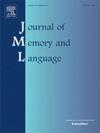The contribution of learning and memory processes to verb-specific syntactic processing
IF 3
1区 心理学
Q1 LINGUISTICS
引用次数: 0
Abstract
Certain aspects of lexical knowledge can be primed by recent usage, with effects observed up to 24 h later in some circumstances. Here, we used syntactically ambiguous sentences (“The man hit/chose the dog with the stick”) to explore the longevity of priming of syntactic structure. Some verbs provide a bias towards an instrument interpretation (the stick was used to hit the dog), whilst others are biased towards the modifier interpretation (the man chose the dog that possessed the stick). Experiment 1 revealed an effect of pre-existing verb bias on resolving syntactic ambiguities. In Experiment 2, we primed specific verbs towards their dispreferred interpretation in an exposure phase (e.g., hit was primed to the modifier interpretation). ∼ 20 min later, the same verbs, along with unprimed verbs, were encountered in syntactically ambiguous contexts in a test phase. Exposure to the dispreferred interpretation in the exposure phase increased the preference for the same interpretation in the test phase, particularly for instrument-biased verbs. In Experiment 3, the exposure and test phases were separated by a ∼ 12-hour interval that included sleep. No overall effect of exposure was found, but again a simple effect of priming was found for instrument-biased verbs. Finally, in Experiment 4 using a sentence completion task, we found that instrument-biased verbs had significantly stronger pre-existing biases, which we discuss as a possible explanation for the imbalance in priming between verb bias conditions. Our results suggest verb-bias priming is maintained over relatively long periods such as 20 min, and possibly as long as 12 h, consistent with a contribution of episodic memory to maintenance of verb-specific syntactic biases.
学习和记忆过程对动词特定句法加工的贡献
词汇知识的某些方面可以通过最近的使用来启动,在某些情况下可以在24小时后观察到效果。在这里,我们使用句法歧义句(“The man hit/chose The dog with The stick”)来探索句法结构启动的寿命。一些动词倾向于工具解释(棍子是用来打狗的),而另一些动词倾向于修饰语解释(男人选择了拥有棍子的狗)。实验1揭示了先存动词偏误对句法歧义消解的影响。在实验2中,我们在暴露阶段启动特定动词,使其倾向于不受欢迎的解释(例如,hit被启动到修饰语解释)。大约20分钟后,在测试阶段,同样的动词和未启动的动词在句法模糊的语境中遇到。在暴露阶段暴露于不受欢迎的解释增加了在测试阶段对相同解释的偏好,特别是对工具偏向动词。在实验3中,暴露阶段和测试阶段之间间隔约12小时,其中包括睡眠。没有发现暴露的总体影响,但对于工具偏向动词,又发现了一个简单的启动效应。最后,在使用句子补全任务的实验4中,我们发现工具偏见动词具有显著更强的预先存在偏见,我们讨论了这可能是动词偏见条件之间启动不平衡的解释。我们的研究结果表明,动词偏误启动维持的时间相对较长,如20分钟,可能长达12小时,这与情景记忆对维持动词特定句法偏误的贡献是一致的。
本文章由计算机程序翻译,如有差异,请以英文原文为准。
求助全文
约1分钟内获得全文
求助全文
来源期刊
CiteScore
8.70
自引率
14.00%
发文量
49
审稿时长
12.7 weeks
期刊介绍:
Articles in the Journal of Memory and Language contribute to the formulation of scientific issues and theories in the areas of memory, language comprehension and production, and cognitive processes. Special emphasis is given to research articles that provide new theoretical insights based on a carefully laid empirical foundation. The journal generally favors articles that provide multiple experiments. In addition, significant theoretical papers without new experimental findings may be published.
The Journal of Memory and Language is a valuable tool for cognitive scientists, including psychologists, linguists, and others interested in memory and learning, language, reading, and speech.
Research Areas include:
• Topics that illuminate aspects of memory or language processing
• Linguistics
• Neuropsychology.

 求助内容:
求助内容: 应助结果提醒方式:
应助结果提醒方式:


